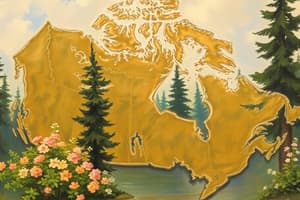Podcast
Questions and Answers
What is a notable feature of life in polar habitats?
What is a notable feature of life in polar habitats?
- Dealing with extreme cold all year round (correct)
- Living in mild weather conditions
- Enjoying warm temperatures throughout the year
- Experiencing frequent heatwaves
How do animals like the Arctic fox adapt to polar habitats?
How do animals like the Arctic fox adapt to polar habitats?
- By migrating to warmer regions
- By hibernating during winter months
- By having black fur to absorb heat
- By developing white fur for camouflage (correct)
What do polar bears mainly feed on in polar habitats?
What do polar bears mainly feed on in polar habitats?
- Grass and insects
- Nuts and seeds
- Fish and seafood (correct)
- Berries and plants
How do people living in polar habitats typically stay warm?
How do people living in polar habitats typically stay warm?
Why do some animals in polar habitats have adaptations like white fur?
Why do some animals in polar habitats have adaptations like white fur?
What is a common characteristic of polar bears when it comes to hunting?
What is a common characteristic of polar bears when it comes to hunting?
What type of plant life thrives in tropical rainforests?
What type of plant life thrives in tropical rainforests?
What type of wildlife is commonly found in tropical rainforests?
What type of wildlife is commonly found in tropical rainforests?
How do inhabitants in tropical regions adapt to seasonal variations in food availability?
How do inhabitants in tropical regions adapt to seasonal variations in food availability?
Which of the following is NOT a common issue caused by high humidity levels in tropical regions?
Which of the following is NOT a common issue caused by high humidity levels in tropical regions?
How do daily routines in tropical regions differ from those in cold weather places?
How do daily routines in tropical regions differ from those in cold weather places?
Which of the following plant species is typically NOT found in tropical rainforests?
Which of the following plant species is typically NOT found in tropical rainforests?
Flashcards are hidden until you start studying
Study Notes
Life in Different Climate Regions
Climate conditions greatly influence the type of life that can survive within them. One notable example is the stark contrast between life nearer the poles and those closer to the equator. Here's how you might find yourself living if you were to relocate to various climate zones around our planet.
Polar Habitats
Inhabiting lands close to either pole means dealing with extreme cold all year round. If you were to move into one of these areas, your daily routine would likely involve wearing hefty clothing just to step outside your door. Snowfall would be commonplace throughout most months of the year. In such climates, people often rely heavily upon insulated buildings for warmth while animals must develop ways to cope with limited sunlight. For instance, some species like the Arctic fox have white fur which helps camouflage it against its snowy surroundings. On the other hand, it may also face predators like wolves during periods where food is more scarce due to longer nights. Polar bears, known as great hunters, live mainly by hunting seals from their den. They’re actually quite lazy creatures — spending much time simply resting! But once they start moving around, they become extremely quick and efficient, needing minimal effort to catch dinner. Such animal adaptations show how nature responds when faced with environmental extremities.
Life in the tropics
As we travel further down towards the equator, temperatures rise dramatically compared to polar climates. This leads to lush tropical rainforests filled with diverse plant life, including trees such as mangroves, bamboo groves, and rare plants like vanilla vines growing up vertical walls. These environments teem with wildlife, including several types of insects, reptiles, birds, primates, and amphibians. Some inhabitants here even eat insects! Food sources tend to be plentiful, although certain times of years might see seasonal variations in availability. Unlike cold weather places, there isn't really any 'preparing for winter', but rather adjustments made according to specific seasons. However, high humidity levels might cause issues such as rust, mold growth or mildew stains on fabrics – something very unusual indeed for polar regions! As a result, daily routines could look drastically different depending on whether you lived in a place like Antarctica versus Brazil's Amazon Basin.
Studying That Suits You
Use AI to generate personalized quizzes and flashcards to suit your learning preferences.




